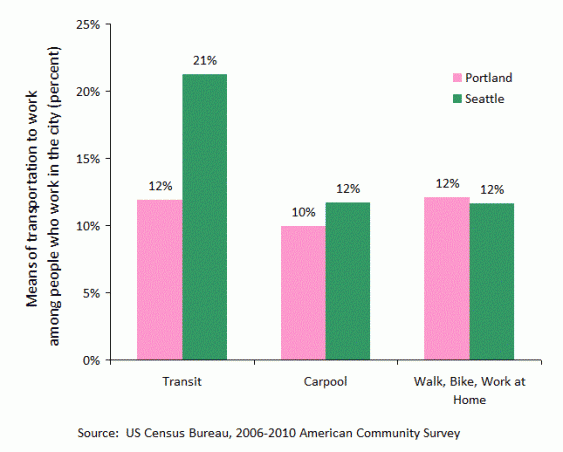Editor’s note: For more transit geekery, check out the follow up post detailing the demographics of Northwest transit riders.
Portland, OR has a national reputation as a transit powerhouse. Despite some recent funding woes—which are depressingly common for US transit systems—the City of Roses’ combination of bus, light rail, street car, and most recently aerial tram transit has earned national kudos. US News and World Report, for example, recently ranked Portland’s transit system as the fifth-best in the country, trailing cities like New York and Boston.
Yet as we’ve mentioned before, data from the US Census shows that Seattle has far more transit commuting than Portland. It’s really not all that close: in Seattle, about 21 percent of workers got to their jobs on transit from 2006 through 2010. But in Portland, the figure is just 12 percent.
The chart above covers people who work in the city, no matter where they live. There’s a similar pattern for people who live in the city proper, regardless of where they work: whichever way you slice the numbers, the Emerald City just has more transit commuting than the Rose City.
In most other respects, the two cities’ commuting patterns are similar. Portland has more bike commuters than Seattle—which comes as no surprise, given Portland’s robust biking infrastructure and flatter terrain. But Seattle has more walkers than Portland; on net, the two cities have nearly identical rates of muscle-powered commuting. Similarly, the two cities have very similar rates of carpooling. The only substantial commuting difference boils down to this: Seattle has more transit riders, and fewer drive-alone commuters, than Portland.
Just to be clear: I’m not saying that transit in Portland is inherently worse (or better) than in Seattle. Strictly speaking, the story of transit commuting isn’t just about transit. It’s largely a story about land use. In part through accidents of geography and history, Seattle has a handful of highly concentrated job centers, particularly downtown and the University of Washington; and transit is a particularly effective commuting option in neighborhoods with high employment densities. And at the same time, high parking costs in Seattle’s downtown discourage drive-alone commuting.
Portland clearly has made a substantial commitment to its transit system. But in the end, even a nifty transit system only goes so far. If you really want to encourage transit commuting, you need to focus on land use. Maybe that’s why Vancouver, BC, beats both Seattle and Portland in transit commuting rates.









TVDinner
Hey, what happened with the first graph? If the percentage of commuters who walk, bike, or work at home is 12% for both cities, why is the Portland bar higher?
Clark Williams-Derry
Good question. Portland is actually a hair higher than Seattle — like, 12.2 vs. 11.9. (I can’t remember the exact figures right now). But I decided to round to the nearest percentage point — I thought the decimals made the chart look too busy & get too confusing. Obviously, though, the choice to omit the decimals was confusing too. Sorry!!
Statistically, they’re tied at ~12%.
And as I look at the second chart, I wonder why I left the decimal points in the carpool figures. I guess I’m just inconsistent. 🙂
TVDinner
You’re allowed. Thanks for the explanation!
Dan
While I agree that the conversation starts with looking at land use, I think there is a bit more to the picture here. Seattle has a much larger “commute shed” than Portland – more commuters dispersed in a larger geographical area. That dispersal of the population creates the need for a robust transit system (or, some would argue, 10-lane freeways.)
For all the flak the Puget Sound region gets for congestion, they need to get some kudos for the network of HOV lanes that allow express transit routes to bypass congestion and make transit a truly attractive and competitive mode. And, Washington as a state has hands down, THE best vanpooling program in the U.S.
It would be useful to know the average commute distance and time of travel of transit users and include that in your comparison. I’m not disagreeing with your basic thesis, but I suspect that transit users in the Puget Sound region are traveling longer distances in their daily commute than Portland region residents.
Clark Williams-Derry
Totally agreed about the HOV system. It’s a *huge* benefit for Seattle transit. Same about vanpools, which deserve much more love than they get!!
Good ideas about looking at commute distance and travel times. I’m not sure I can get distance from Census data — but they do have travel time.
For drive-alone commuters who live in the city, it’s 23.9 minutes in Portland, 24.9 minutes in Seattle.
For transit commuters who live in the city: 39.1 minutes in Portland, 35.0 minutes in Seattle.
For folks who work in the city (regardless of where they live):
drive-alone commuters: Portland = 27.7 minutes, Seattle = 32.2 minutes;
transit riders: Portland = 41.8 minutes, Seattle = 45.2 minutes.
That’s potential fodder for another post — thanks for the idea!
I’m not sure I follow you on population *dispersal* necessitating robust transit. My read is that population dispersal generally makes transit more expensive and less effective; concentrating housing generally boosts transit ridership, and concentrating jobs boosts transit commuting. Our last look at the numbers showed that population was actually a little more concentrated in Portland than Seattle; but I haven’t compared the cities on metrics of job concentration. But this is a complicated topic, and I certainly don’t want to quibble before I understand your point!!
Jorgy in PDX
You also should compare transit service levels – revenue hours or vehicle headways. If Seattle has a better system (more routes/higher frequency), then you would expect a high rate of use.
Also, need to control for 2010 economic conditions and compare employment levels. Did Portland get hit harder by the Great Recession than Seattle? The general perception down here is overall traffic levels were/are way down because of fewer work trips.
Dan
Where I was going with the population dispersal thought was the amount of commuting going on in the Tacoma to Seattle corridor. Sound Transit operates commuter rail, plus express bus service to serve that corridor’s commute needs. That’s a dynamic and service need we really don’t have to the same extent in the Portland region. You’re absolutely right about how population density affects efficiency and effectiveness. Maybe a better way of stating my idea was in terms of how the Puget Sound area has two fairly substantial cities at each end of a 60 mile or so corridor. So it’s not necessarily a textbook case of sprawl (suburbs and exurbs surrounding a large city), but more along the lines of a large city providing employment for some residents of a medium-sized city and smaller towns in between. The Salem to Portland corridor is the closest thing Oregon has to compare, but there’s nowhere near the population in that corridor. So that’s why I was saying that the Puget Sound had a need for the level of transit service it provides.
Great follow up post today, too. Thanks!
John Niles
Thanks for this report, an eye opener that confirms the effectiveness of King County Metro, one of the best transit systems in America. The result is for the Central City right? Seattle-Tacoma-Bellevue region beats the Portland-Vancouver, WA region too, but by a narrower margin as I recall.
The region matters. We are growing and spreading out, or so says the 2010 Census.
Interestingly, the Puget Sound Regional Council’s regional forecasting model out to 2040 does not show the Seattle region’s growing expenditure for mass transit rail making as big a difference in future mode share as would the planned, quite large, ongoing investment in buses.
Bus ridership in these parts comes out in the 2040 forecast as four times rail ridership, despite a full light rail network extending to Everett, Redmond, and Tacoma with commuter rail from Everett to Lakewood.
In fact PSRC computes the rail ridership with Sound Transit’s future network — completely built out with new ST3 taxes — as having lower train ridership in 2040 than Sound Transit forecasts the trains will have in 2030 with just the ST2 extensions from the Prop 1 taxes approved in 2008. Go figure.
While no official explanation of this anomaly has been offered, I’ve figured that this result is because of the concurrent PSRC plan to have WSDOT put SR 520 style road use fees on all of the region’s expressways during the 2030s. This strategy comes out in the forecasts as (1) keeping the expressways free-flowing, including for buses, and (2) driving a knife into the heart of rail transit volumes which depend on freeway congestion for attractiveness.
Based on PSRC’s state-of-the-art, award-winning planning, plus other forecasts of what’s coming in smart-road, complete-streets, connected-vehicle technology, Puget Sound’s bus and van pool dominant transit system is going to make both Portland’s and Sound Transit’s souped-up light rail subway trolley cars look primitive and silly as the years go by. Buses and shared-ride vehicles go more places than trains, not to mention cheap, driverless taxicabs by 2040. (There, I said it, and PSRC didn’t! This is the technological extension of ZipCars).
Michael, Portland Afoot
And just as transit commuting isn’t just about transit, transit isn’t just about transit commuting.
Despite Portland’s smaller size, cheaper auto parking and the huge disadvantage Clark notes on transit commute trips, we still exceed the Seattle area on transit boardings per capita.
These observations are accurate and important, and I don’t mean to do a sibling rivalry thing. Still, it’s arguable that by concentrating financial resources on the daily back-and-forth commute rather than on making service in the urban core excellent around the clock, the Seattle area is subsidizing sprawl by increasing the ease of suburban life. Do you know how non-rush-hour transit service levels stack up, Clark?
Clark Williams-Derry
Great question! I looked at this a few years back, and concluded that greater Portland has more transit boardings per capita than greater Seattle. But Vancouver, BC beat both of us by a country mile!!
http://www.sightline.org/2007/05/11/transit-update-vancouver-still-riding-high/
http://www.sightline.org/2007/05/15/is-the-skytrain-the-limit/
Of course, these numbers are subject to all sorts of confusion — particularly because they mix data for entire metro areas, including both urban and rural areas. A better comparison would look at urbanized areas in particular — e.g., rides in urbanized areas vs. population in urbanized areas. But that’s hard to tease out from bus data — it may be impossible, but it’s an awful lot of work.
But you’re 100% right: there’s a major tendency in transportation debates to focus on commuting. But even during rush hour, much (some data says the majority!) of driving is for non-commuting trips. Commuting is something on the order of 1/4 of miles, 1/5 of trips0, if I recall correctly.
I hope I haven’t contributed to the conflation of commuting & transportation overall, but I probably have. Sigh…
Iridius
Taking the numbers from each transit authorities’ websites, and factoring in population, the total ridership numbers provide even clearer results. What’s interesting though is that I hear more and more that Portland has a superior transit system. Unfortunately, the cost per boarding for TriMet is $17.34, whereas Metro is $4.68 (numbers based on the 2010 reports available via the National Transit Database).
Keith Cotton
Thanks for posting this comparison, Clark. I agree that different land use patterns and an effective HOV network have something to do with it. However, I think it is also important not to overlook the impact of Washington state’s 20-year partnership with employers through the commute trip reduction (CTR) program. By engaging employers in transportation, CTR creates the opportunity for employer investments in transit that increase ridership by their employees.
Since the CTR program began in 1991, employer investment in commute benefits has steadily increased. Today about 1,100 of the largest employer worksites in the state’s urban areas implement commute options programs. In the Puget Sound region, many employers choose to subsidize transit passes and vanpool fares for their employees. These employer programs are a big part of the success of our state’s vanpool program.
Employers invest in the CTR program because providing a benefit to their employees—while reducing demand for parking—has a real impact on their bottom lines. The benefit that transit agencies get from this partnership with employers cannot be overstated. Currently almost 1,500 employers and other organizations purchase a transit pass and other benefits from King County Metro through the ORCA regional smart card program. These organizations distributed approximately 500,000 ORCA cards to employees, students, faculty and other commuters in 2010. The value of Metro’s fare revenue collected directly from employers in 2010 was $75.4 million, more than 50 percent of the agency’s fare revenue for the year.
Portland has a similar program to CTR called Employee Commute Options (ECO). The ECO program exempts employers in districts that meet specific criteria, which may reduce the amount of transit subsidies provided by employers for commuting.
If you follow my logic that CTR is partially responsible for Seattle’s higher rates of transit commuting, I am curious how the two cities compare for overall transit use. I assume that for other trip purposes and at other times of the day, Portland may show a more comparable or even higher rate of transit share.
(Full disclosure: I work on statewide transportation demand management programs in Washington state.)
Clark Williams-Derry
That’s a great point — and a very interesting comparison between the two cities.
A question for you — do you happen to know how many of the employers that subsidize ORCA passes operate either in downtown Seattle or the U district?
I suspect that this is an area where land use & transit are self-reinforcing: a combination of congestion, high parking costs, and decent transit options make transit an attractive option for both employees and employers, which fuels the CTR programs, which convinces policymakers & administrators that it’s worthwhile to keep supporting CTR & downtown transit, which makes transit a more attractive option. And so on. But if transit weren’t such a good commuting option for downtown and the U District to begin with, I have to wonder if the CTR program could have had the tremendous successes it’s had…
Greg King
Clark, I can partially answer your ORCA question, at least in regard to employers that are affected by CTR law.
In downtown Seattle, 91% of CTR-affected employers provide some sort of subsidized ORCA pass. 65% of CTR employers provide an ORCA Business Passport Card to their employees which not only covers full fare for bus, light tail and Sounder, but also 100% VanPool subsidy.
I don’t have a U-district breakout, but for the city as a whole there is only a slight drop off to 86% of all CTR employers providing a full or partially subsidized ORCA pass to employees.
Not surprisingly, and likely in at least some part to those passes, Seattle CTR employers have a 37% transit mode share based on CTR survey data. That jumps to 46% to downtown CTR worksites.
Additionally, region-wide, while CTR companies account for only 23% of all Business Passport accounts, they account for 85% of the actual passes.
(Hi Keith!)
Ethan
Clark… nice work, as usual. Three factoids that would be fun to ponder: how do people get to transit? Are ferries part of transit in Seattle? What does geography have to do with it, if anything? Great food for thought. Thanks!
charlie
Next step in your inquiry might be “why?” Though of course you’re right about land use, I’m wondering about the respective SEA and PDX transit agencies. How is their funding base different? And what about their attitudes? For several years, TriMet has been paring schedules and routes, which cuts off lots of people. They appear to have little interest in new ideas: our neighborhood ass’n tried for years to improve area ridership, with what might be good ideas. TriMet just doesn’t seem interested. Their rationale: union drivers demand routes that offer good places to rest (w/facilities), only certain distances, etc. Buses going by (not stopping for us) are headed to GARAGE from far-flung dead-ends. Just seems it could be smarter all around. Attitude? Or other issues?
Clark Williams-Derry
Fantastic suggestion about looking into the “why” of transit performance. Agreed about TriMet cutbacks & institutional inertia. Of course, I hear many of the same complaints about bus service in greater Seattle — there’s been some interesting movement of late, but allocation of bus service in Seattle has been a political sticking point for years. It strikes me that it might be tough to quantify those sorts of “institutional culture” differences!
But it might be much easier to look at the # of buses, funding, the kind of funding base each system uses, etc. I’ll try to wrap my head around that, if I have a “spare” moment. (Drat, who am I kidding–I never have a “spare moment” anymore….)
Ted
Among persons who work in Seattle, 45% use transit, carpool, walk, bike, or work at home. Among persons who live in the city, the percentage is 46% – among persons who work in Seattle, 21% use transit while among persons who work in Seattle, 19% use transit. Transit use is no better in the city than between the suburbs and the city. This seems to imply that Seattle needs a better urban transportation system.
Nathan
Clark, question, if you’re still tracking this (so to speak). Tri-Met, rightly, boasts of its almost unbroken 23 year record of increasing ridership. Does King County Metro have a similar record?
I’ve been to Portland and Seattle, ridden transit in both places, so I understand the differences. But really, from a national, maybe even a West Coast, perspective, the two cities seem more alike than different. Or more like each other than like anyplace else (except Vancouver BC, if one ignores the fact that it’s in Canada!).
Clark Williams-Derry
Good question!
Metro annual ridershipo data is here:
http://metro.kingcounty.gov/am/reports/annual-measures/ridership.html
Trimet is here:
http://trimet.org/pdfs/publications/trimetridership.pdf
I’d have to go deep into the files to get 23 years worth of data. It looks to me like Trimet has more consistent ridership increases than Metro (though Trimet has had a couple of years of modest declines in the 2000s). King County Metro stats may be complicated by overlapping transit jurisdictions: the Puget Sound area has at least 5 transit agencies (King County, Pierce County, Snohomish County, Kitsap County, and Sound Transit), so gains in one system may be offset by losses in another…